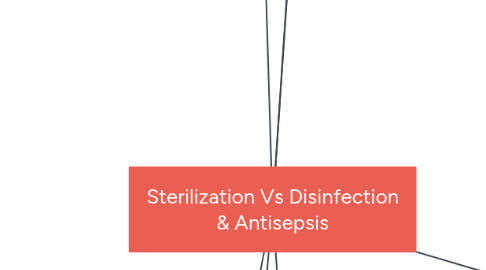
1. Antisepsis
1.1. Use of chemical agents on skin or living tissue**
1.2. No sporicidal activity is implied
1.3. Used to REDUCE number of microbes on skin
1.4. to reduce their numbers prior to surgery or venipuncture or bandaging a wound.
1.5. Agents
1.5.1. Alcohols (70% isopropyl) – nontoxic, drying, no residual activity. Is inactivated by organic matter, clean with soap and water first
1.5.2. Iodophors – limited residual activity, inactivated by organic matter, often used with alcohols for disinfecting skin
1.5.3. Chlorohexidine – broad antimicrobial activity but slower to kill than alcohol. Has residualactivity, but inactivated by organic material and high pH.
1.5.4. Triclosan Active against bacteria only Found in deodorant soaps and some toothpaste
1.5.5. PCMX- IS LIMITED TO GRAM + NON TOXIC AND HAS RESIDUAL EFFECTD
2. Sterilization
2.1. Define
2.1.1. use of physical or chemical methods to destroy ALL forms of microbial life including fungal and bacterial spores.
2.1.1.1. Used for critical items that will enter tissue or vascular systems or items through which blood will flow
2.1.1.1.1. (surgical instruments, needles, IV catheters, IV meds)
2.2. Mechanisms
2.2.1. Physical
2.2.1.1. MOIST Heat
2.2.1.1.1. **(autoclaving or use of steam under pressure) denatures proteins, disturbs cell membranes
2.2.1.2. Radiation
2.2.1.2.1. **Radiation crosslinks DNA preventing replication
2.2.1.3. Filtration
2.2.1.3.1. HEPA filters are used to remove bacteria and fungi from the air
2.2.2. Gas Vaprs
2.2.2.1. Gas vapor sterilants such as ethylene oxide are used to sterilize items that cannot be autoclaved (moist heat). Highly flammable, explosive
2.2.2.1.1. Ethylene oxide (ETO) at 29-65°C for 2-5 hours,
2.2.2.1.2. Plasma gas sterilization
2.2.3. chemical
2.2.3.1. Chemical sterilants are less toxic
2.2.3.2. 0.2% peracetic acid, an oxidizing agent that is nontoxic
2.2.3.3. 2% glutaraldehyde, a toxic alkylating agent
2.2.3.3.1. TAKE CARE
2.3. Examples
2.3.1. Bacterial spores (Bacillus atrophaeus) Coccidia (Cryptosporidium)
3. Disinfection
3.1. use of physical or chemical methods to destroy MOST forms of microbial life; spores and other “resilient organisms”
3.1.1. **“resilient organisms” such as mycobacteria, viruses, and fungi may survive
3.2. Disinfection Levels
3.2.1. Level is selected by the relative risk that the surfaces pose as a reservoir for pathogens;
3.2.1.1. Most resistant
3.2.1.1.1. Prion reprocessing
3.2.1.2. High
3.2.1.2.1. (almost sterilization, kills spores)
3.2.1.2.2. For semicritical items that will come in contact with mucous membrane or nonintact skin (except dental items)
3.2.1.2.3. Agents
3.2.1.2.4. High-level is almost sterilization, kills spores
3.2.1.3. Intermediate
3.2.1.3.1. Used to clean surfaces or instruments in situations where spores and resilient organisms are not expected
3.2.1.3.2. Intermediate-level does NOT kill spores or resistant organisms
3.2.1.3.3. Some semicritical instruments and devices such as flexible fiberoptic endoscopes, laryngoscopes, etc; some noncritical items
3.2.1.3.4. Examples
3.2.1.3.5. Agents
3.2.1.4. low
3.2.1.4.1. Agents
3.2.1.4.2. Examples
3.2.2. o Presence of C. difficile or pseudomonas aeruginosa
3.2.3. Surfaces contaminated with blood require a higher level
3.2.4. critical instruments require a higher level.
4. Effectivness of Lethal Agents
4.1. The medium in which the organisms are present
4.1.1. **Presence of organic matter (e.g., pus, serum or blood)
4.1.1.1. Greatly diminishes the activity of many lethal agents
4.1.1.2. A result of absorption and inactivation of the agent by protein colloids present in the material
4.2. Temp
4.3. PH
4.4. Concentration
4.4.1. Of Agent
4.4.2. Of Organism
4.4.2.1. Heterogeneity of population relative to susceptibility/ sensitivity to agent
4.5. Presence of endospores**
5. Key Words/Practice Questions
5.1. Phelbotomy
5.1.1. 70% isopropyl alcohol‐
5.1.1.1. this is the most appropriate compound to use for antisepsis (reducing number of microbes on a living surface such as the skin) prior to venipuncture
5.2. Drop an instrament in surury
5.2.1. Steam sterilization (15 minutes at 250°F at 15 psi)‐ the process of Flash sterilization is a modified version of steam sterilization
5.3. clean a patient room with C. diff
5.3.1. Chlorine solution (1:10)
5.3.1.1. – of the choices listed this is the only one that would destroy spores formed by C. difficile and could be used practically to
6. Infection Control
6.1. Hand Higene
6.1.1. Standard Precautions
6.1.1.1. Means
6.1.1.1.1. Standard precautions are a set of infection control practices that healthcare personnel use to reduce transmission of micro-organisms in healthcare settings.
6.1.1.2. 2 million patients a year get a hospital-related infection and many infections are transmitted onthe hands of healthcare personnel
6.1.1.3. When?
6.1.1.3.1. They should be used by healthcare personnel caring for patients regardless of the patient’s diagnosis and whether or not the patient has an infection.
6.1.1.3.2. In other words, Standard Precautions should be used for all patients, all the time.****
6.1.1.4. They Include
6.1.1.4.1. Hand Hyggiene
6.1.1.4.2. PPE
6.1.2. Common Problems
6.1.2.1. Healthcare personnel practice hand hygiene about half the time they should. Hand hygiene is often not practiced:
6.1.2.1.1. Hand Hygine
6.1.2.2. Handlotions
6.1.2.2.1. Hand lotions are important to prevent skin dryness and irritation. You should use only hospital-approved hand lotions. Other lotions may:
6.1.2.3. Fingernails
6.1.2.3.1. Keep your natural fingernails short to about ¼ inch
6.1.2.3.2. Do not wear artificial nails when having direct contact with high-risk patients (e.g., ICU, OR)
